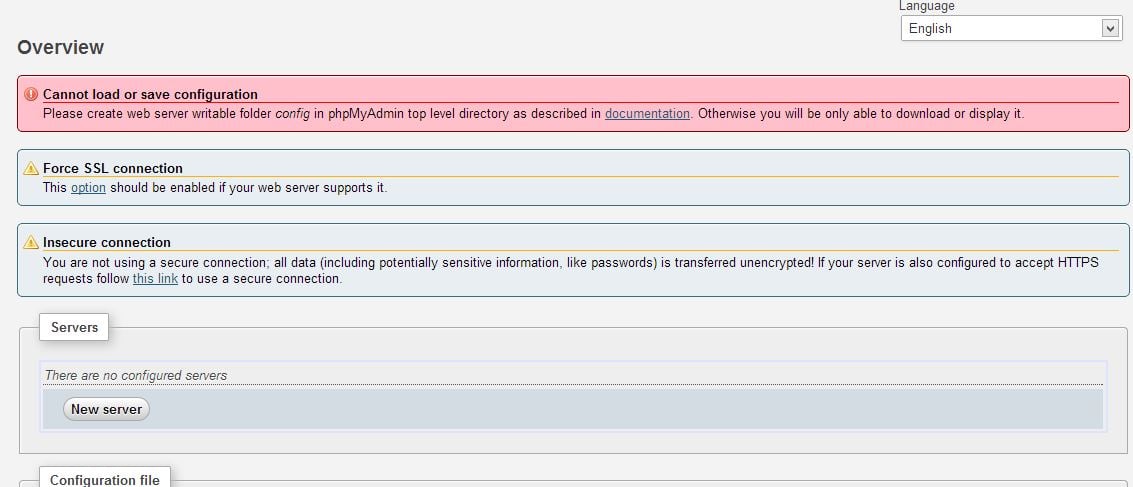Hello dear friends on daniweb.
i have a problem i have hotst package on 1and1.com now is 9 months.... i it is 6 months i try to install latest phpmyadmin but still i can't i don't know how
i had download phpMyAdmin-4.0.4-all-languages zip i unziped and i upluad on www.myadomainname.com/phpMyAdmin-4.0.4-all-languages
but i don't know how to configure... i have 3 database in my package when i access to www.myadomainname.com/phpMyAdmin-4.0.4-all-languages there is a phpmyadmin user interface who need password and username ... i put my data base user name and password but it don't work, i have contacted 1and1 suport center and never i had them help about it and decide today to post my problem here i hope you help me thank you.
chrisschristou 0 Posting Whiz
Recommended Answers
Jump to PostCan you avoid running phpmyadmin from accessible docroot? It may be better to run from cPanel/Plesk only.
Jump to PostFollow these steps:
- delete
config.inc.phpfile;- under
www.myadomainname.com/phpMyAdmin-4.0.4-all-languages/create the directoryconfig;- change permissions of this new directory to 644 or, if it does not work, to 755;
- then reload the setup page, the red message will disappear, after that just click on Add new server to insert the credentials …
Jump to PostCan you avoid running phpmyadmin from accessible docroot? It may be better to run from cPanel/Plesk only.
Chris in addition to diafol's suggestion, if you can connect to the database from your localhost installation (XAAMP or WAMP), then install PHPMyAdmin in your computer, so you can manage it …
Jump to Posti contacted 1and1 support they told me it is not possible
Ok, it means the database server accepts connections only from allowed IP, as your server IP, so it won't work from your PC.
Regarding 755 and 644 these are system permissions, 644 equals to
read + write…
Jump to Postit folder when you say directory??? right???
Yes :) Folder is the name of the graphical representation (the icon) of the directory. You can try with 777, but this is not the best setting, so: check if with 777 the error message disappears, then setup PHPMyAdmin, check if …
All 21 Replies
cereal 1,524 Nearly a Senior Poster Featured Poster
chrisschristou 0 Posting Whiz
bradly.spicer 47 Posting Whiz in Training
cereal 1,524 Nearly a Senior Poster Featured Poster
chrisschristou 0 Posting Whiz

diafol
cereal 1,524 Nearly a Senior Poster Featured Poster
cereal 1,524 Nearly a Senior Poster Featured Poster
chrisschristou 0 Posting Whiz
cereal 1,524 Nearly a Senior Poster Featured Poster
chrisschristou 0 Posting Whiz
cereal 1,524 Nearly a Senior Poster Featured Poster
chrisschristou 0 Posting Whiz
cereal 1,524 Nearly a Senior Poster Featured Poster
chrisschristou 0 Posting Whiz
cereal 1,524 Nearly a Senior Poster Featured Poster
chrisschristou 0 Posting Whiz
cereal 1,524 Nearly a Senior Poster Featured Poster
chrisschristou 0 Posting Whiz
cereal 1,524 Nearly a Senior Poster Featured Poster
chrisschristou commented: help full thank so much friend +2
chrisschristou 0 Posting Whiz
Be a part of the DaniWeb community
We're a friendly, industry-focused community of developers, IT pros, digital marketers, and technology enthusiasts meeting, networking, learning, and sharing knowledge.


